Software Productivity Consortium: An example of an improvement community Werner Schaer. 1.* - unedited transcript -
I want to give you an introduction to an organization that was founded fifteen years ago. I will point out the differences of what you have heard so far, and what we are trying to do. First of all, what we one of the oldest consortium. What we heard before is that you need to worry about decaying links, sustaining growth, and reinventing yourself to stay relevant and current. That has really been the history of the consortium. The idea was essentially born out of the need to make significant improvements on software productivity out of the mid-eighties.
It was initially funded by large aerospace companies. They each initially put in three million dollars for three years in order to get this effort funded. We wanted to do is find what the tools, methods, frameworks, and processes that are out there to somehow deduce the practice. How you reduce the practice is take a twelve or twelve hundred page Ph.D. thesis, and enable it in such a way that a professional at their desk can actually use it. That is what we have been doing, and we have evolved significantly. I would like to share with you what the dynamics are as to why it's working and why we are evolving.
First of all, we find being that the government and privately funded is an important aspect of continued growth and stimulation between the two communities. Exclusive funding has some limitations in today's interaction between government and private. If you are talking about community of learning then, the transaction model that is typically inherent in a consulting activity model, doesn't lend itself because typical transactions are by definition going to end. A large part of the value of sharing resources is also the exchange of best practices or the exchange of anything that will seem to relate to improving performance. In the early 80's there were strategic decisions being made by companies and they were strategically funded. In today's environment, unless this strategic decision can be made in terms of business results, it has been increasingly difficult to get private and commercial organizations support that. We have put emphasis on measuring what we are doing and how we work with the organizations. Finally, the non-profit model as you will see by the community that we are interacting with, in order to have the largest group of interacting communities, we need to make sure that there are not obstacles in there that would to prevent the interaction from happening. For instance if you are a commercial organization and you are trying to get the government to interact with you very openly, and there are all of these hurdles there and obstacles over there.
Just briefly who our members are..... There are still a lot of aerospace companies. You basically find five industries primarily represented. Aerospace industries, financial institutions, IT Companies, some electronic companies, and telecommunications. Basic members is an invention that came about five years ago because initially, the idea was that we would have large corporations because they have large purses to fund this effort. Increasingly we realized that unless we could tap into smaller organizations, start up organizations eventually, and be able to insert those ideas into the consortium activities, we would deny ourselves from an important source of knowledge and knowledge exchange. Basic members are those companies who typically operate at less than a hundred million dollars a year. Therefore, they don't contribute that much in terms of money into the organization or to the technical program. The full members direct the activities of the consortium in both the technical and business forms. There is a board of directors. Each of the full members has a board member. Each of the full members has also a technical advisory board member who directs the activities of the consortium. The co-opting of the user community in to the consortium is an important aspect of having a continuation. Service members are those companies who are currently trying us out. They are staying here, and want to feel their way into the consortium and if they feel it is beneficial to them they will continue.
In addition to commercial organizations, we have government organizations, academic affiliations, and non-profit industry affiliations. As these organizations are working with us, each party needs to find the benefit in collaboration with the community. They have found, as we have found, that there is an advantage and incentive to communicate and work with each other. One of the things when you deal with commercial organizations that will continue to help you grow is to understand what these commercial organizations are driven by. Look at a simplistic abstract of what the business priorities are of the organization that we are working with. At least as they relate and are impacted by IT and software in general, you can see that they generally fall into five or six categories.
The reason that is important to us is that if you focus on a given activity with in the consortium, it is important that the members who are a part of consortium really get a benefit out of it. They will not get benefit out of it if their priorities are not being met. That is why it is important for us to understand that. In addition to that, in order for it to be a vibrant community, where everyone felt that they were giving and taking to the right kind of proportion, we felt that the companies that should be members should meet certain criteria.
Mainly that software is critical to the company's success. If it is not on the radar screen, they are probably not going to be a very active member. They need to have a demonstrated commitment to improving systems/software processes and technology. The other thing we found that there are companies who feel that they already know everything there is to know. There are other companies that are ready and willing and interested to learn. Those that you have a dialogue with that already know everything is very difficult to make any progress with and it is quite frankly a waste of time. In order to be in the mainstream of the activities that are going on in any consortium, they need to have representations of recognized leaders in the industry. It is important to us that there is that representation.
In order to conduct our business technically, we do a lot of tracking. We do a lot of research as to what is going on. Most importantly, we get input from the academia, from government, and from business and then we get the input and direction from the actual members. What we as a consortium staff do is really the technology industrialization. To take whatever promising technologies are coming and we industrialize them and package them. Make them ready so individuals can use them. We are currently dealing with a community of about a hundred thousand professionals that are represented in each of these corporations. We are probably interacting with about ten percent of them on an ongoing basis. In order to do this we have learned lessons as far as transfer technology with in the consortium. They come in the form of tools, methods and consulting services. One shoe or size does not fit all. We thought we were very clever in doing interactive CDs in order to spread around. Only to find out that there are companies that want to have the flexibility of videoconferences, other companies who want lunch seminars and workshops. The other companies want to have videotapes. They are doing exercises in the evening. There are various ways about how information is being transmitted today. The feedback that is coming back from the consortium, as far as needs, it is both the result of the experiences with products and the services. As well as their own sense of what is important to them in order to continue the cycle. These cycles are anywhere from six to eighteen months depending on what product we are talking about.
If there is on thing that we have learned a lot of lessons about are how to do that and how not to do that. If the organization doesn't feel they are getting the benefit from it eventually they are going to go away. The organization is going to atrophy. To be able to leverage the knowledge and information out in the community is one of the most important aspects of an ongoing consortium. The innovative tools that are available today obviously, we are all interested in and experimenting with, but it is also a difficult process that we will reach to whole community.
Depending on what kind of project you run, in our case running a consortium means that we have to maintain a relationship and understanding with literally all levels of management, of our commercial members and public members. We heard before that a school board member or a supervisor doesn't necessarily appreciate or think the same way as a professional down in the trenches. The communication with all levels of management is an important aspect of conducting a consortium. In addition, we do have account directors who's mission it is to actively work with individual members to make sure that there is a human interaction going on not just an electronic communication going on so that they take advantage of these means.
Finally, if you stand back and look at why the number of all these members that are participating with us, you can typically categorize them into five reasons. Some of them participate with us because it is technical leverage. They do not want to staff this type of capability, they can't afford to staff it with in the company, and the rate of return is in other words is much bigger than if they would conduct those types of activities themselves. Participating with us and getting the benefits of the technologies many companies derive competitive advantages from this. Government contracting for instance this technology makes the difference of run off of two or three million dollar programs in terms of productivity that results from being asserted there. There are marketing advantages that are important to some members. Like a trademark, being certified is a in certain circles a competitive advantage. That is one of the reasons why some of our members participate as actively as they do. In any community that interacts and is vibrant, people not only talk about tics on a child's head, they talk about how they are going to solve a business problem, and who they are going to partner with there is a lot of business communication going on. As a result, they are marketing referrals and teaming arrangements being made in any community. This is no exception. That has proven to be very important. The best practice in benchmarking is one of the things we struggled with the most, initially, because the really important information is not voluntarily or easily shared amongst companies. If "Block E. Martin" is achieved a fifty percent productivity improvement, as the result of certain test automation technology, they are not anxious to share that with "Bowing" We struggled with that. I am happy to report that the climate has changed dramatically over the last five years. Companies are now much more willing and interested to share benchmarking and best practices information that is fairly detailed, partly because they making significant progress steps every year. So that if I share with you what progress I make this last year, it is not going to be easy to figure out what type of progress I am going to make next year. It is not easily extendable and many of the companies are making significant steps forward in anything that they do. To give you a whiff as a closing comment. One of the most exciting and new technologies that our members are inserting into their organizations is based on modeling technologies and frameworks that are combined with automation tools. The measured effects and impacts in the area of productivity have now reached several factors. Before we were talking twenty to thirty percent a year. So this is where most of our advanced members are putting their energies now. Again, there is a lot more to talk about. It is a working consortium but we have to learn a lot of things to make it work you go though the fifteen-year history, you see the ups and downs and I am happy to say that some of these lessons are paining out. We are now growing in terms of membership, about thirty to thirty-five percent a year. The important thing is to understand how to transition a publicly funded project into an ongoing improvement community that carries forward beyond the initial funding. That is the challenge that we have to overcome. Thank you.
---
Above space serves to put hyperlinked
targets at the top of the window
|

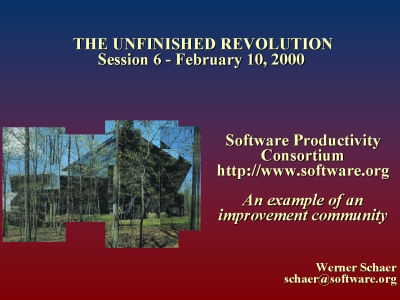 Fig. 1
Fig. 1 Fig. 2
Fig. 2
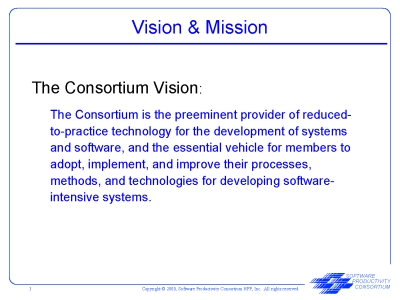 Fig. 3
Fig. 3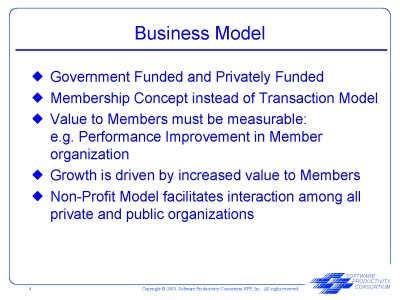 Fig. 4
Fig. 4 Fig. 5
Fig. 5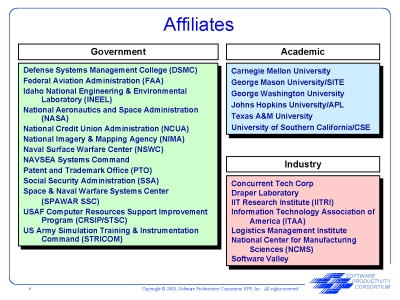 Fig. 6
Fig. 6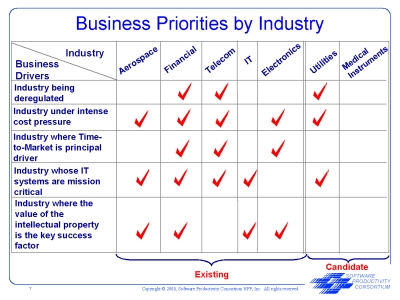 Fig. 7
Fig. 7 Fig. 8
Fig. 8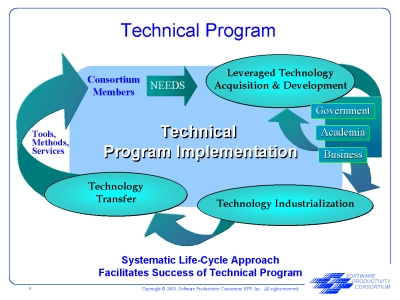 Fig. 9
Fig. 9 Fig. 10
Fig. 10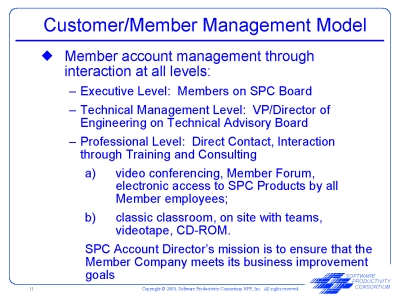 Fig. 11
Fig. 11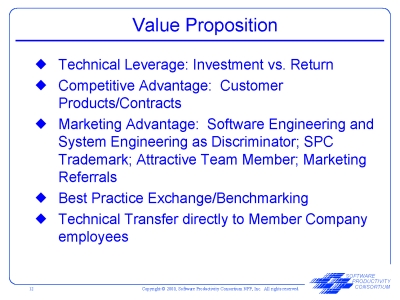 Fig. 12
Fig. 12